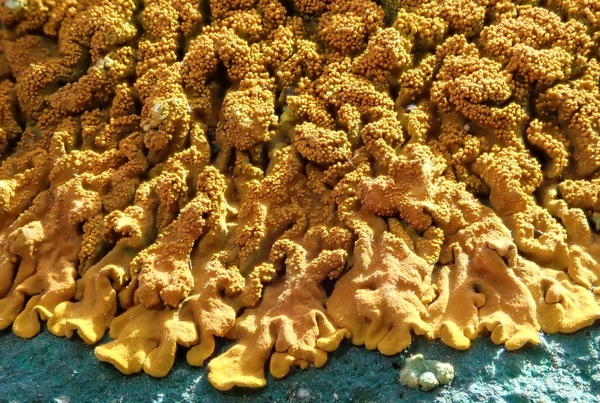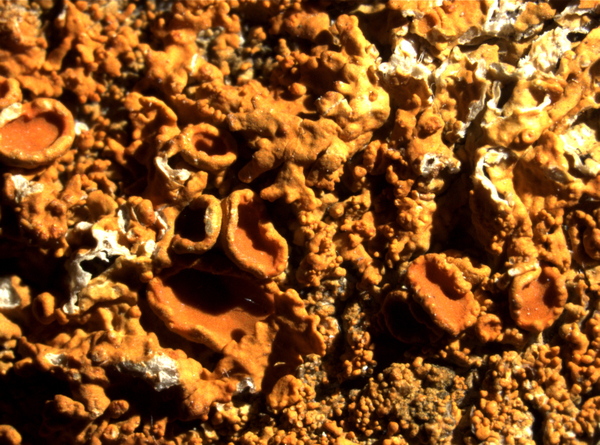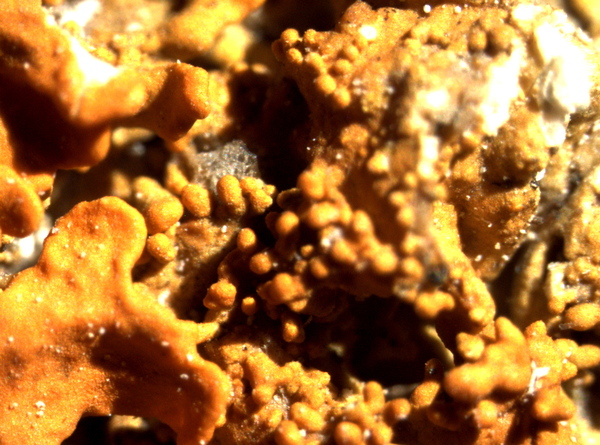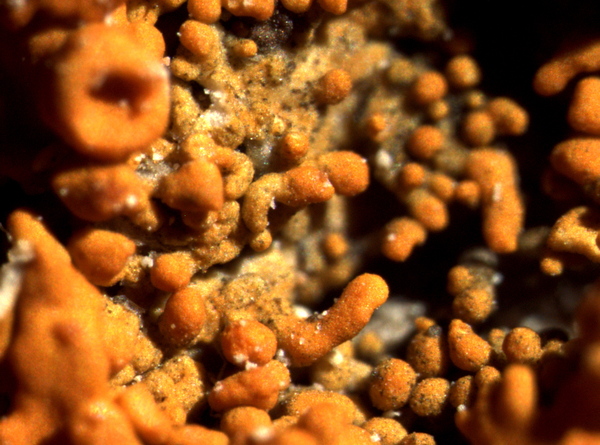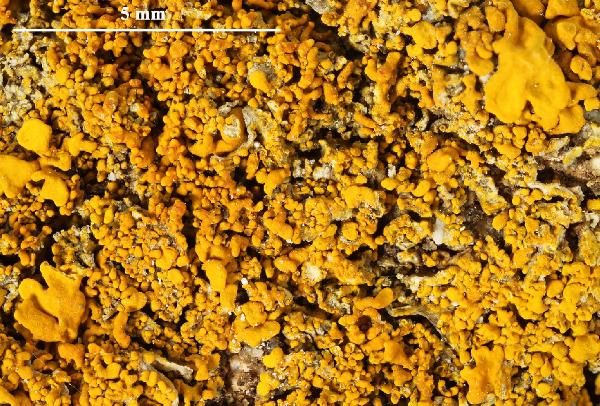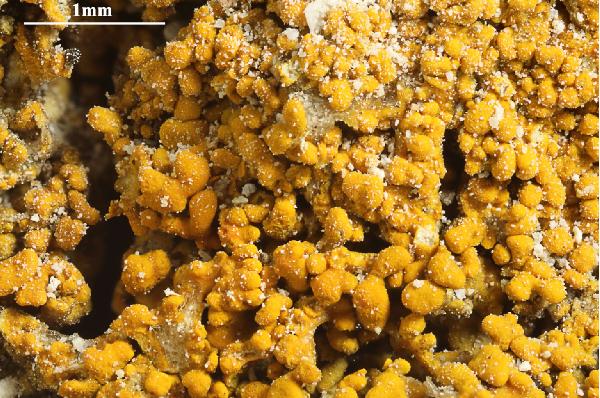Xanthoria mediterranea Giralt, Nimis & Poelt
J. Hattori Bot. Lab., 74: 275, 1993.
Synonyms: Physcia parietina var. isidioidea Beltr.?; Xanthoria isidioidea (Beltr.) Szatala?
Description: Thallus foliose, heteromerous, dorsiventral, orange to orange-yellow, rather firmly attached, forming 2-3 cm wide, orbicular rosettes which soon tend to coalesce into irregular, much larger thalli. Lobes 2-3 mm wide, flat, rounded at apex, with at first wart-like, then clavate to cylindrical, c. 80-200 µm thick, simple to sparingly branched, terete or slightly flattened isidia; lower surface pale, attached to the rock by irregular, coarse, whitish hapters. Upper and lower cortex paraplechtenchymatous, the former 10-20 µm thick, the latter 15-20 µm thick, the cells 4-7 µm in diam.; medulla white, rather lax, most hyphae running parallel to the substrate. Apothecia very rare, lecanorine/zeorine, up to 3 mm across, with a concave, deep orange disc and a usually somewhat paler, smooth to isidiate thalline margin. Epithecium brownish-orange, K+ purple-red, hymenium and hypothecium colourless; paraphyses simple or sparingly branched, septate, swollen at tips. Asci 8-spored, clavate, functionally unitunicate, apically thickened with a broad internal beak, the inner part of apex and external cap I+ blue, Teloschistes-type. Ascospores 2-celled, polarilocular, hyaline, ellipsoid, 12-16 x 6-8 µm, the equatorial thickening (“septum”) 4-6 µm. Pycnidia immersed into dark orange warts. Conidia hyaline, ellipsoid, 2-3 x 1.2-1.8 µm. Photobiont chlorococcoid. Spot tests: cortex K+ purple-red, C-, KC-, P-, UV+ intensely orange-red. Chemistry: thallus and apothecia with unidentified anthraquinones, but most probably with parietin (major), fallacinal, emodin, teloschistin and parietinic acid.
Growth form: Foliose, broad lobed
Substrata: rocks
Photobiont: green algae other than Trentepohlia
Reproductive strategy: mainly asexual, by isidia, or isidia-like structures (e.g. schizidia)
Commonnes-rarity: (info)
Alpine belt: absent
Subalpine belt: absent
Montane belt: absent
Dry submediterranean belt: extremely rare
Humid submediterranean belt: extremely rare
Padanian area: absent
pH of the substrata:
1 2 3 4 5
Solar irradiation:
1 2 3 4 5
Aridity:
1 2 3 4 5
Eutrophication:
1 2 3 4 5
Poleotolerance:
0 1 2 3
Altitudinal distribution:
1 2 3 4 5 6
Rarity
absent
extremely rare
very rare
rare
rather rare
rather common
common
very common
extremely common
Loading data...
Occurrence data
Predictive map
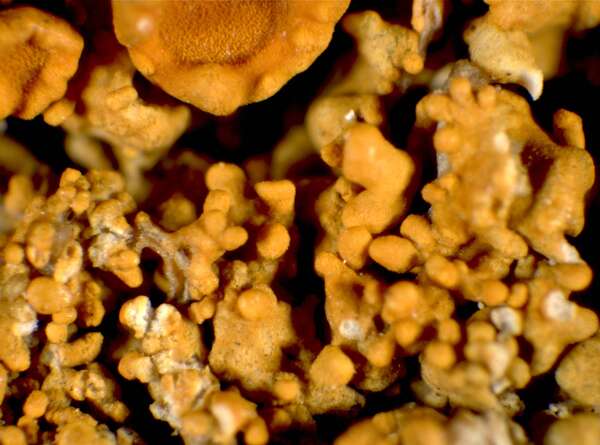
P.L. Nimis; Owner: Department of Life Sciences, University of Trieste
Herbarium: TSB (7566)
2001/12/03
detail of isidia
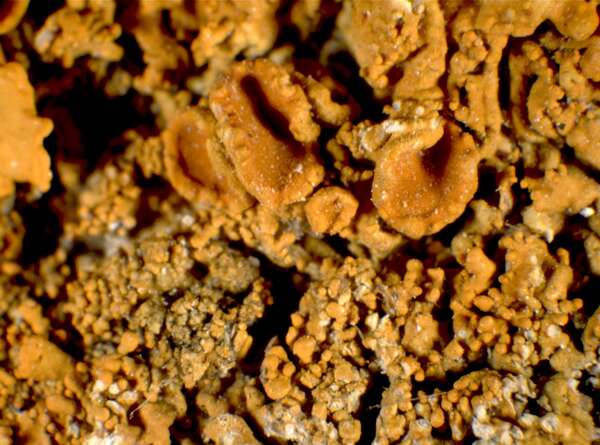
P.L. Nimis; Owner: Department of Life Sciences, University of Trieste
Herbarium: TSB (7566)
2001/12/03
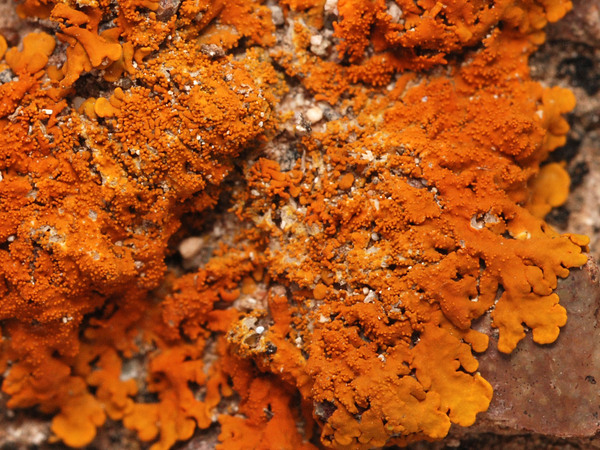
Leif Stridvall - Courtesy: Anita Stridvall - Source: http://www.stridvall.se/lichens/gallery/
as X. isidioidea
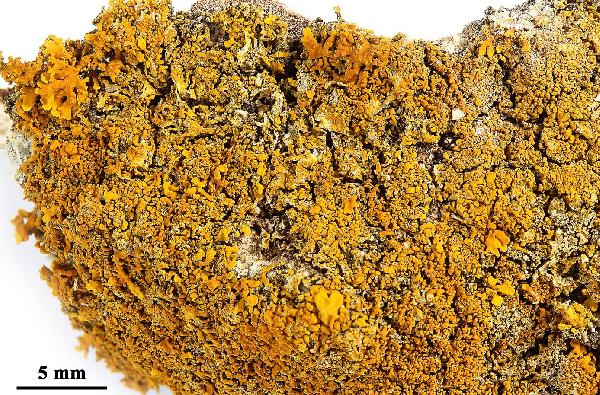
Felix Schumm - CC BY-SA 4.0
[13697], MALTA: Bingemma Chapel südlich von Zebbiegh,
35°54.220' N, 14°22.631' E, 150 m. Leg. F. Schumm, N. Stapper, M.
Lüth & J.-P. Frahm 12.03.2008, det. S.Y. Kondratyuk.
Growth form: Foliose, broad lobed
Substrata: rocks
Photobiont: green algae other than Trentepohlia
Reproductive strategy: mainly asexual, by isidia, or isidia-like structures (e.g. schizidia)
Commonnes-rarity: (info)
Alpine belt: absent
Subalpine belt: absent
Montane belt: absent
Dry submediterranean belt: extremely rare
Humid submediterranean belt: extremely rare
Padanian area: absent
pH of the substrata:
| 1 | 2 | 3 | 4 | 5 |
Solar irradiation:
| 1 | 2 | 3 | 4 | 5 |
Aridity:
| 1 | 2 | 3 | 4 | 5 |
Eutrophication:
| 1 | 2 | 3 | 4 | 5 |
Poleotolerance:
| 0 | 1 | 2 | 3 |
Altitudinal distribution:
| 1 | 2 | 3 | 4 | 5 | 6 |
Rarity
absent
extremely rare
very rare
rare
rather rare
rather common
common
very common
extremely common
Loading data...
Occurrence data
Predictive map

P.L. Nimis; Owner: Department of Life Sciences, University of Trieste
Herbarium: TSB (7566)
2001/12/03
detail of isidia

P.L. Nimis; Owner: Department of Life Sciences, University of Trieste
Herbarium: TSB (7566)
2001/12/03

Leif Stridvall - Courtesy: Anita Stridvall - Source: http://www.stridvall.se/lichens/gallery/
as X. isidioidea



